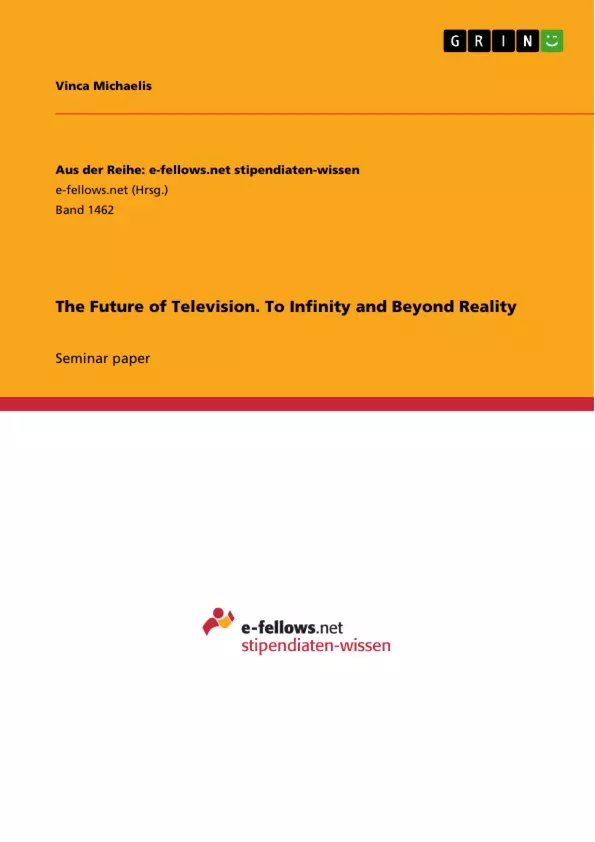The media sector is changing and TV is right at the centre of this development. Everybody is or wants to be “connected” with their friend, so TV has to be too. The world is moving fast and people want to watch TV when and where they have time for it. The flood of information swamps the audience. For TV to become more targeted it has to be personalized. Finally, TV should not just be an “incidental medium” as is common to- day. TV should be an experience, so it has to be more interactive (Neef, Schroll & Hirsch, 2011).
But what will happen in 20 years?
There has to be an innovation that combines all these needs. Time to take a look at a science fictional future: Star Trek – and their one idea that combines all these aspects – the holodeck.
“A holodeck is a room that creates objects, people and images on the fly and has no restriction on time and space” (Rhodes, 2008, p. 1)
Going first a couple of steps back, the following paragraphs will then explain the hypothesis: “holodeck, the ultimate idea of future television in 20 years” by looking at the four main innovations in the television industry, the reasons for their use and their connection to the ultimate idea of future television – the holodeck. Finally, taking into consideration how advanced the technology is and what lies ahead to create the holodeck?
The voyage starts by looking at the current developments and what lies ahead to boldly go where no one has gone before.
This research paper is based on a review of literature.
Inhaltsverzeichnis (Table of Contents)
- Introduction
- Methodology
- A brief history
- Uses and Gratifications
- TV Innovations
- Get connected
- Share the experience
- Be part of the programme
- "TV just for me"
- Lean backward, forward or jump-in!
- The ultimate idea, the holodeck
- Holograms
- What is a hologram?
- How far are we?
- Three great ideas towards the holodeck
- 360° Fulldome Worlds
- Sony's real life holodeck
- The Reality Deck
- Holograms
Zielsetzung und Themenschwerpunkte (Objectives and Key Themes)
This research paper aims to investigate the hypothesis that the holodeck represents the ultimate vision for television in 20 years, by combining four current innovations: connected TV, social TV, interactive TV, and personalized TV. It explores these innovations, their underlying reasons for use, and their connection to the concept of the holodeck. The paper also examines the technological advancements in holography and assesses the feasibility of creating a holodeck within the next two decades.
- The evolution of television and its convergence with emerging technologies
- The role of user needs and motivations in shaping television innovation
- The potential of the holodeck as a future television experience
- Technological advancements in holography and their implications for media
- The future of television in the context of technological convergence and user engagement
Zusammenfassung der Kapitel (Chapter Summaries)
The introduction sets the stage by outlining the research hypothesis and introducing the concept of the holodeck as a future television technology. It highlights the need for innovation in the television industry to address the changing needs and expectations of audiences.
The methodology chapter details the research approach, outlining the sources of information used, such as journals, internet sources, and books. It specifically mentions key publications that provided insights into the history and future of television, as well as the four key innovations: connected TV, social TV, interactive TV, and personalized TV.
The chapter on "A brief history" provides a general overview of the evolution of television and its current trajectory. It emphasizes the dynamic nature of technological advancements in the media landscape.
The chapter on "Uses and Gratifications" delves into the motivations and reasons behind audience use of television. It explores how user needs and desires shape the development and evolution of television technologies.
The chapter on "TV Innovations" examines four significant innovations in the television industry: connected TV, social TV, interactive TV, and personalized TV. It discusses the features, benefits, and potential of each innovation, highlighting their relevance to the concept of the holodeck.
The chapter "Lean backward, forward or jump-in!" explores the evolution of media consumption, categorizing the different phases of engagement with television. It places the four innovations within these phases and positions the holodeck as a "Jump-In" experience.
The chapter "The ultimate idea, the holodeck" delves into the concept of the holodeck as a future television technology. It examines the technology of holography, discussing its current capabilities and future potential. The chapter also presents three specific ideas for holodeck implementation: 360° Fulldome Worlds, Sony's real life holodeck, and The Reality Deck.
Schlüsselwörter (Keywords)
The research paper focuses on the key concepts of television innovation, user engagement, technological convergence, and the potential of the holodeck as a future television experience. It explores the role of connected TV, social TV, interactive TV, and personalized TV in shaping the future of media. The paper also examines the technological advancements in holography and their implications for the development of immersive media experiences.
- Quote paper
- Vinca Michaelis (Author), 2014, The Future of Television. To Infinity and Beyond Reality, Munich, GRIN Verlag, https://www.grin.com/document/300636



